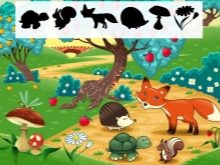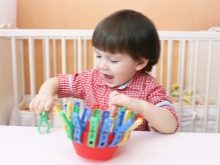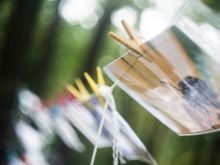Clothespin games
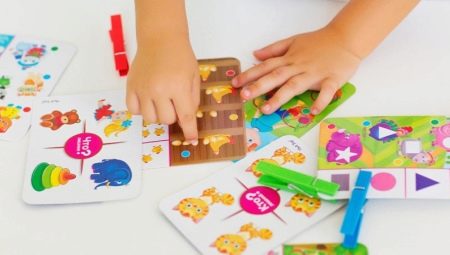
Play is considered the leading activity for a preschooler. Through it, he learns the world, develops, because games make up most of his day. Both independent and with adults. Mothers often notice: the child prefers household items to other bright toys - he is simply attracted by pots, spoons and, for example, clothespins. But the latter have become part of the most real educational games.
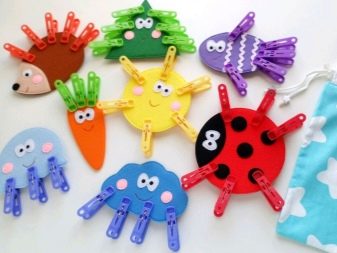

Choice of clothespins
The set of clothespins is inexpensive, they come in a variety of colors, and colorful patterns for games are of course preferable. As for the material, it can be either plastic or wood. It is important that the spring of the clothespins is not the strongest. It is better not even to take new ones, but to play with the used ones - from frequent use they cease to be very tight, which means they cease to be dangerous for the child. A new and tight clothespin can pinch a baby's finger, and it is quite painful. If you decide to take wooden ones, you need to pay attention to their processing. If the wood is not sufficiently processed, burrs may remain on it. When a child interacts with a clothespin, burrs can enter under the baby's skin. This is dangerous.
With plastic clothespins, these problems will not arise, but they themselves are considered less environmentally friendly. But, as a rule, there are more bright shades among plastic clothespins. And there are small stationery clips, which sometimes replace linen. But you can't play with young children like that, their motor skills are not developed so as to handle small objects.And the small size is also dangerous because a two-year-old may want to try a clothespin "for the tooth", and now this is already a threat to his health.
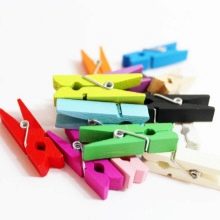
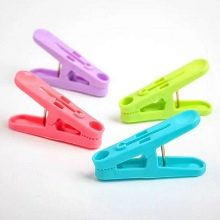
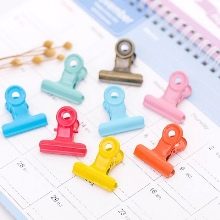
Review of games for toddlers 2-3 years old
Guys of this age are the most grateful players with clothespins. But at the same time, a game is really needed: with a script, condition, rules.
"Find a clothespin"
Attention games are very important for toddlers up to three years old, and indeed, for an early age, they are considered an integral part of developmental activities. The game is simple: you need to hang clothespins in various places in the room. But so that it is not very difficult. The child's task is to find all the clothespins and bring them to the designated place. A prerequisite - they must be at the level of the child's eyes.
You can ask your kid to collect clothespins in a box. For each found he needs to be praised, encouraged. You can use the words "warm-cold" when looking for clothespins. It is important that they do not just lie, but hang in the working position.
So, they can be attached to a pencil holder, to a folder in a closet, to a curtain, to the back of a chair, etc.

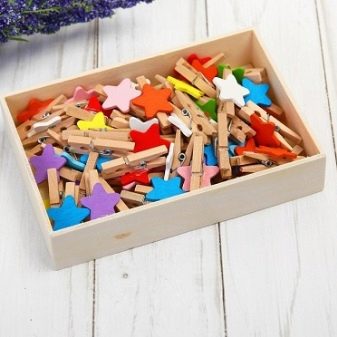
"Where is whose tail?"
You need to print images of animals without tails, and their tails will be a separate printout. Of course, paper animals will quickly become unusable, so you need to laminate the images. And then the teacher connects the animals with tails, but at the same time replaces them: for example, a bunny will have a fox's tail, a squirrel will have a zebra's tail, etc.
The child should be asked to unhook the clothespins, separate the wrong pairs and make them up correctly. So, you can combine two tasks: an exercise in recognizing and making the right combinations, and working with a clothespin (that is, the development of fine motor skills).
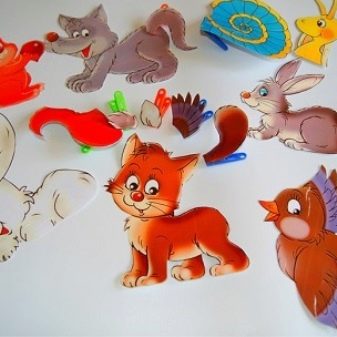
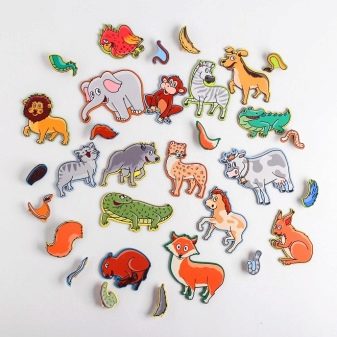
"Complete the picture"
This job also requires printing a template. This is a standard circle-face with many potential complement options. The child needs to supplement the face-circle so that it turns into a specific hero, and supplement it with clothespins. What options can there be: the sun (clothespins form rays), a light bulb (several rays at the top), a flower (petals are formed from a clothespin), beets or carrots (tops), etc. Of course, both the circle itself and the clothespins must match in color with a possible way.
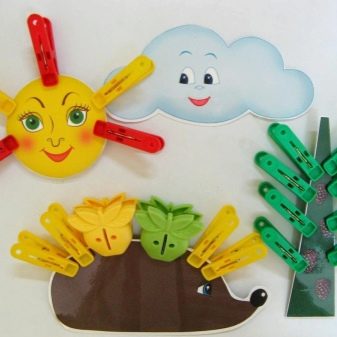
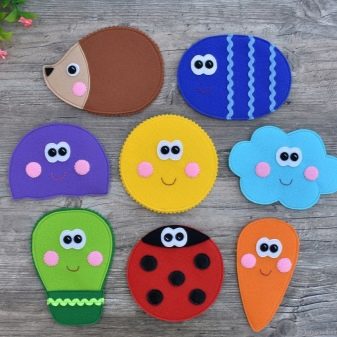
"Take off the bugs"
Clothespins in this situation become bugs that attack everything around. They can "sit" on the sleeve of the child's sweater, on the teacher's clothes, on other things and objects nearby. The task of the kid is to remove the bugs without missing a single one. You can complicate the task, put 3 boxes of different colors in front of the child, and the bugs need not only be removed, but immediately distributed among the boxes according to the principle of color matching.
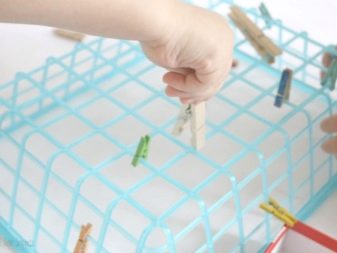
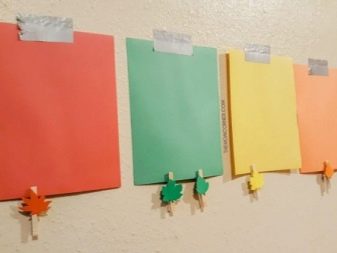
Exploring colors
At the age of 2, colors are already definitely studied with the child, this happens all the time, not in the process of just some one game. And clothespins will also help make this kind of study more fun. It is necessary to print a circle with multi-colored sectors, and then also small circles of different colors. And these circles must be attached to the appropriate clothespins.
More precisely, there are two options: the first is to connect the circles with the desired sector (and then it does not matter what color the clothespin is), the second is to immediately attach the clothespins of the desired color to the sector of the same color.
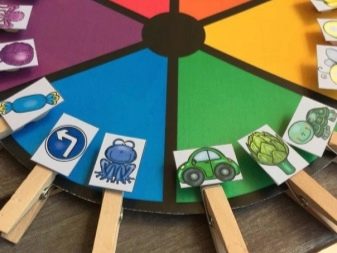
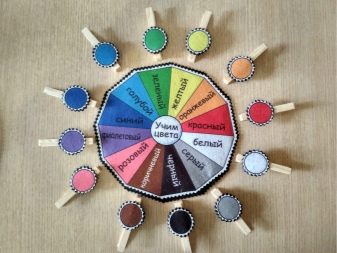
"Who eats what?"
Usually this game is started when the children already know what the ladybird “says” and what the doggy says. Further in the study of animals, one can advance in relation to their, one might say, dietary habits. And again we need printouts - a circle with sectors, which will act as a table at which animals dine. And print the circles with the drawn animals. The task of the kid is to find its place at the dinner table for each animal. The latch will help secure it in place.

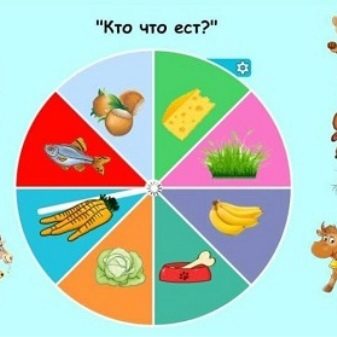
"Where is my house?"
And then, after lunch for the animals, the game can be continued. Only now each hero must go to his own house.Suppose the animals got confused, forgot where they live, and only a child can help them find their way home, in the end - fix the animal in the place where its house is with a clothespin.
These are only the basic, most common options for games that both develop the child's thinking and help train his fine motor skills. Children in the younger group (and they are already 3 years old) respond well to such tasks, understand the task.
You can even collect them in small groups of 2-3 people and offer joint games.
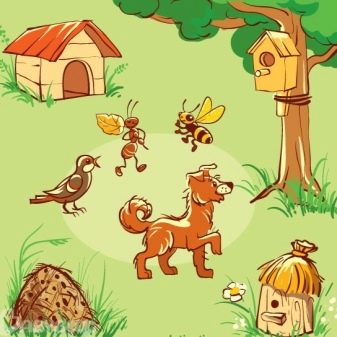
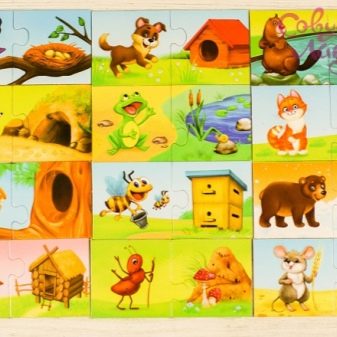
Options for children 4-6 years old
The older the child, the easier it is to handle the braces, and the tasks can be complicated. Already the main goal will not be the development of fine motor skills, but the development of counting skills, familiarity with numbers and letters. And, of course, children continue to study the world around them, nature, animals, etc. Didactic games appear more and more often, and they can also be combined with tasks with clothespins. The most famous games for the middle group in the preschool educational institution:
- Find a shadow. The child receives a circle with objects, and each depicted object needs to choose its own shadow. That is, find a match, analyze. It is necessary to correlate the object and the shadow in a certain amount of time and connect the two pictures with a clothespin.
- "Seasons". This game is about natural history. The child receives a circle divided into 4 sectors according to the seasons. And next to each sector there are empty fragments, in the place of which there should be pictures with either natural phenomena or with landscapes corresponding to a specific season of the year. And they are also fixed to the circle with clothespins. You can even designate a specific color of the clothespin.
- "Colors and numbers". Each number has its own color. And so does every cell in the color palette. You need to connect the number to the color in the palette using clothespins. You can also give this task for a while.
- Simple math games. They are held in the senior group, where there are already the first lessons in mathematical preparation. The same games can be combined with outdoor games, for example, made part of a relay race. Hang a few clothespins on a rack with a stretched rope. The child's task is to run to the counter and make it so that there are 2 clothespins (and there were, for example, 5 of them). The child runs, counts, runs back. The next child should add a given number of clothespins, etc.
- Photo drying. This game can be combined with a family action, such as are often arranged in kindergarten. For example, March 8 is coming. And the children were invited to bring a photo with their mother from home in order to arrange a photo drying (this is what photo exhibitions are called). The task of the children: count as many clothespins as needed to fix each photo on a string. And then hang the photos with clothespins. The teacher can complicate the task: for example, photos with boys and mothers need to be attached with blue clothespins, with girls and mothers - pink. Thus, the children will analyze the task and practically organize the exhibition themselves.
After playing with older children, you can ask the latter to assemble the clips themselves, put them in boxes. If it is a distribution by color, size or material, so much the better. Interesting game finds!
